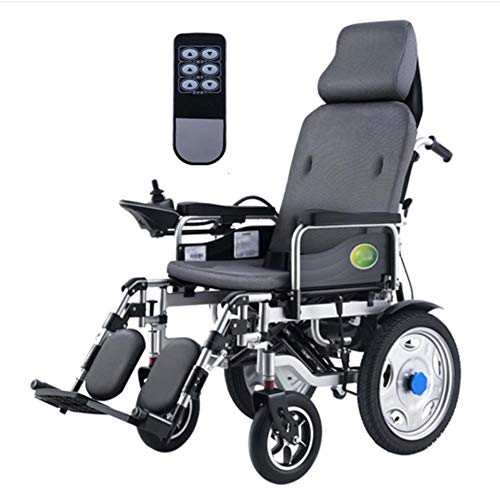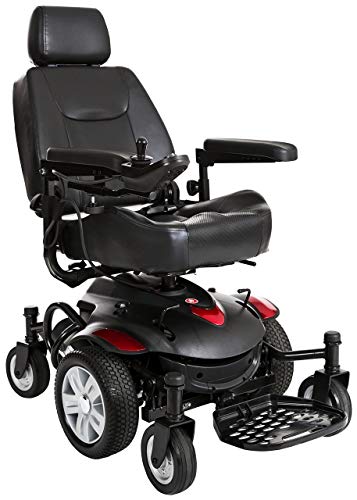15 Pinterest Boards That Are The Best Of All Time About Electric Wheel…
페이지 정보
작성자 Hollis Tudor 작성일24-11-25 13:29 조회3회 댓글0건본문
 electric powered wheelchairs compact electric wheelchair With Joystick
electric powered wheelchairs compact electric wheelchair With JoystickJoysticks for power wheelchairs can improve their user-friendliness and independence. Standard joysticks are not able to be able to accommodate the unique characteristics of hand disorders.
This study evaluated the efficacy and satisfaction of custom-designed power wheelchair joysticks made using 3D printing technology. Modified power-mobility indoor driving assessment (PIDA), National Aeronautics and Space Administration task load index, and the psychosocial impact of assistive devices scale were used for evaluation.
Control
The control system for a power chair includes two key elements: the joystick and the electronics. Standard joysticks are mounted on the left or the right side of the wheelchair, while more advanced rehab chairs feature swing-away mounts that allow the joystick to move into the middle of the seat.
The manner in which a joystick is mounted and used is crucial to its effectiveness for a customer. For example in the case of someone who has significant tremors, it is crucial to ensure the joystick is designed in such a way that these actions will not cause accidental activations of the chair. Standard EPW joysticks use proportional input devices that react to the deflection of the gimbal to control the chair's movement (similar to an electronic game controller or automobile accelerator pedal).
There are a myriad of alternatives to control options for power wheelchairs that require very little force to activate. Controls for switches, sip-and-puff head arrays, sip-and-puff controls, and chin controls are all accessible. While some of these controls require a separate interface to connect them to the heavy duty electric wheelchair uk, many are compatible with the new generation of joysticks, which have integrated Bluetooth into their handles.
Some of the standard wheelchair joysticks come with a screen to display the status of the system and provide feedback to the user, which can be particularly useful for those with cognitive or visual impairments. Other advanced joysticks come with the ability to control a variety of accessories like environmental controls and even a tablet or TV.
Whatever the technology, a joystick can only be useful if it's comfortable for the user to operate. It is therefore important to consider the size of the buttons as well as their location on a joystick in order to make them easy to access. It is also important to consider the sensitiveness of the joystick which can be adjusted to a variety of levels according to the needs of each individual user.
Comfort
A joystick-controlled powerchair provides many advantages that aren't available with manual chairs. They reduce fatigue caused by operational issues and permit longer travel distances over manual wheelchairs. Additionally, they can be used in places that are smaller and have more challenging terrain than a manual one, for example, uneven surfaces or slopes in the outdoors. With this added mobility users can enjoy an ease of movement that gives new life to their lives and reminds them of how great it is to be able to move around independently.
There are a variety of powered wheelchairs that are available, each with their distinct characteristics. The number of bells and whistles the particular model comes with will depend on what the user prefers and needs. A few of the most popular features include:
Controls on an Outdoor electric wheelchair electric wheelchair to buy that have a joysticks can be adapted to fit individual needs. This includes the type and location of the ball, knob, or handle. Joysticks are usually located on the armrest of the driver's seat, while others are placed on the front or rear of the seat to make it easier for attendants to reach. They can also be placed on the sides of the seat for those who have limited shoulder mobility or muscle weakness.
Other features are more personal in nature like the size and style of the joystick display screen. Some models are backlit or have colors that are easier to read for people with poor vision. Other models provide additional modes that provide audio or visual cues to help navigate. Other models may include odometers, clocks, and battery charge indicators.
Another crucial aspect of the joystick is how it can be controlled in narrow turning radius. The best models will have a narrow turning radius, making it easier to maneuver through obstacles and narrow spaces such as hallways. The narrow radius makes it easier to maneuver through public areas and stores. This tight turning radius is particularly beneficial for those who have mobility issues, such as cerebral palsy, multiple sclerosis, ALS Huntington's disease, spinal cord injury or brainstem stroke.
Safety
Power wheelchairs have been designed with safety as a priority. They have reliable brake systems that can reduce the speed as quickly as the consumer presses the joystick control. They also have anti-tip wheels at the rear to prevent the chair from tipping backward.
The most popular type of joystick is a proportional control, which is similar to automobile accelerator pedals as well as video game controllers in that the more the joystick moves away from its center, the speed at which the wheelchair moves. Joysticks that require finger dexterity and good proprioception to operate. Joysticks that are standard are mounted on the armrest. However there are several specialty controls that mount the control on the side or middle of the seat.
Even with specialized rigging some people might not be able to turn a handle. Certain people who suffer from spasticity could have issues because their muscles may become stiff or weak. In these instances it is possible to use a head control device that converts the movement of a consumer's head into the required command for the wheelchair might be a better option.
The size and position of the buttons on the joystick is another aspect to be considered. If the buttons are far forward or hard to reach, they could hinder the seating position of the user, and cause a strain on the hands. If the joystick is too far back, it may be difficult to move the chair or turn the wheels.
The seatbelt must be fastened on an electric light weight wheelchair wheelchair. The most powerful wheelchairs can travel at speeds up to 8 mph and a seatbelt that isn't fastened could result in serious injuries or even death. Batteries must be charged regularly and, ideally, every night. This will ensure that they live longer and ensure their efficiency. You should also keep your chair checked regularly to ensure that all parts are working properly.
Accessories
The joystick is an essential element of any power wheelchair, and there are numerous accessories that may be added to enhance its functionality. These range from basic switches to more sophisticated interfaces that connect to communication devices, or external environmental control units. A more expensive power wheelchair is likely to have several controller components that can be utilised and configured to meet the needs of a specific client. A non-expandable control will only accept the proportional stick as an input device while an expandable one will also accept sip and puff controls, special switches, as well head array systems. Some of the more advanced controllers can operate up to two power seating actuators which can alter the seat's angle and position of the seat.
The most basic kind of joystick used in the clinic is a proportional control, also called a motion sensing joystick. This type of joystick responds to the force by increasing output (i.e. the speed of the wheelchair) the further the stick is pushed away from the center. This requires a significant amount of intact proprioception and dexterity for efficient use.
The technology used today is able to compensate for a small movements in amplitude during EPW driving. However, it cannot detect and adjust for more severe unintentional motions, such as those caused higher amplitude tremors or involuntary movements not associated with conscious intention like athetosis.
 The majority of wheelchairs can be programmed and customized with the help from a medical professional. These parameters include changing the torque generated by the motor, changing the speed that the chair moves and setting the dead zone which is the amount within which the EPW is unable to produce an output. Some controllers also allow the clinician to save backup programs. This is helpful in an emergency or when a patient's symptoms alter.
The majority of wheelchairs can be programmed and customized with the help from a medical professional. These parameters include changing the torque generated by the motor, changing the speed that the chair moves and setting the dead zone which is the amount within which the EPW is unable to produce an output. Some controllers also allow the clinician to save backup programs. This is helpful in an emergency or when a patient's symptoms alter.댓글목록
등록된 댓글이 없습니다.




